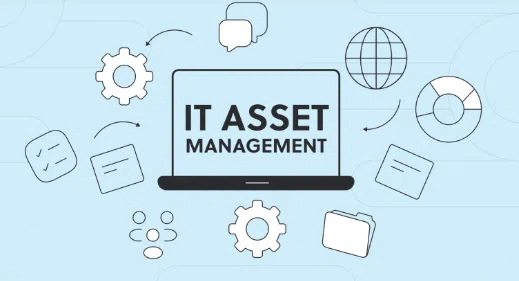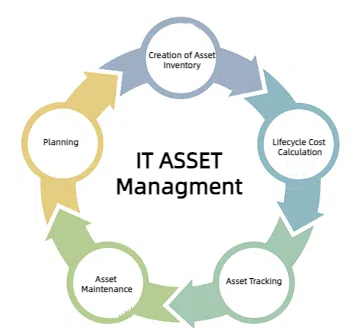What is IT Asset Management (ITAM)?
As an organization, you definitely want to make informed decisions in terms of how you allocate and utilize all your resources. This is where IT asset management (ITAM) comes in handy as one key aspect in managing and optimizing all the technology assets you rely on for your enterprise operations. Well, this quick guide will tell you everything you need to know about IT asset management including the features, the process, use cases, and more:

1What is IT Asset Management (ITAM)?
For starters, ITAM is essentially the process of acquiring, deploying, maintaining, upgrading, and disposing of your organization’s IT assets, whether tangible or intangible.
In other words, ITAM can help you track the management of all your IT equipment's life cycle, from the time the asset is acquired and used to the time it expires and is disposed of.
IT assets in this case can be company-owned devices, hardware or software. Hardware assets include computers, tablets, printers, laptops, data center infrastructure, servers, and network devices.
On the other hand, software involves in-house developed software, software licenses, and digital data. There are also other key IT assets like lease agreements for company facilities and infrastructure.
2The Importance of IT Asset Management
Generally speaking, implementing proper asset management for IT will help you create a well-functioning and resilient IT environment as an organization.
Here is a sneak peek into some of the benefits you are bound to reap from a business operations and strategy perspective:
1 Streamlines Operational management and efficiency
A comprehensive asset management strategy creates clear processes and responsibilities. This clarity streamlines workflows hence reducing manual interventions and risks of errors.
Of course, your team will save more time and energy for other critical tasks as an enterprise!
2 Improving Asset Visibility
You’ll also get the ability to discover and clearly track the life cycle of your IT assets. In other words, you'll generally have control over their entire life cycles. This makes it easier to optimize your IT assets to improve your business functions.
3 Increased Asset Security
When you track and manage your IT assets, you can easily identify potential security risks and vulnerabilities that pose a threat to your business. You can then take proactive steps to address them before they can severely impact your organization.
4 Improved Analytics and Reporting
Asset management for IT also streamlines how you collect, analyze, and interpret data for informed decision-making. You can analyze and interpret to identify patterns, trends, and bottlenecks in your organization.
5 Improved Accountability
You can easily obtain information regarding the location, condition, and the assigned personnel at a given time. For example, in a scenario where your IT asset is lost or stolen, it is easier to find and hold the right person accountable.
You can also track the purchase and disposal of the assets, making it easier to identify potentially flawed deals that can prove costly to your organization.
3Main Features of IT Asset Management
For an ITAM to work effectively, it must have certain key tenets or rather, features:
Real-Time Asset Tracking:
This is the basic albeit the most important feature of Any ITAM. Yes, proper ITAM should let you obtain real-time information regarding the location, condition, ownership, and other crucial aspects of asset management for IT.
If any of these parameters change on the asset end, the respective parameters should also change accordingly on the ITAM.
This can also include asset check-in and check-out features, especially for those extremely valuable assets. With real-time asset tracking, an organization can make accurate decisions because it is based on the latest information.
System Integration:
Your company will probably often want to use the ITAM system in tandem with other tools or systems in the business ecosystem. This is why an effective ITAM strategy should therefore allow you to integrate with their preexisting or new systems for other processes with minimal or no additional resources.
Detailed Reporting:
One of the most important aspects of any system is reporting and ITAM is not an exception. A proper ITAM should generate in-depth reports for better decisions. These reports can be used by various personnel across different departments for decision-making and documentation.
Alerts and Notifications:
A comprehensive ITAM system should include alerts and notifications. Whenever a fault occurs on the remote asset, the system should capture and send the notification for action by the respective personnel.
It should also keep detailed logs of these alerts and notifications for future reference and usage.
Alerts and Notifications:
A comprehensive ITAM system should include alerts and notifications. Whenever a fault occurs on the remote asset, the system should capture and send the notification for action by the respective personnel.
It should also keep detailed logs of these alerts and notifications for future reference and usage.
4The Process of IT Asset Management
IT asset management encompasses the entire process from deployment to asset expiration and disposal. Let’s expound more on some of the key processes in ITAM:

- 1.Creation of Asset Inventory
- Asset inventory is the first step in every ITAM system. This is where you create detailed inventory of the respective IT assets in your organization.
- Here you will add relevant information about the items including location, date of purchase, price, department, and responsible personnel if any among others.
- 2.Asset Lifecycle Cost Calculation
- Once you have enrolled your assets in ITAM, you now need to calculate the lifecycle of these assets. This will help you predict and plan effectively for potential purchases and disposals.
- Here, you will consider an array of factors that affect the cost of your items with time including maintenance, capital, and the cost of disposal.
- 3.Asset Tracking
- Again, asset tracking is at the heart of any ITAM system. The tool should help you to continuously monitor the condition and other relevant parameters of your assets. Whether it is real-time or after specified intervals, asset tracking ensures you get visibility of your assets and relevant updates regarding your assets.
- 4.Asset Maintenance
- Again, asset tracking is at the heart of any ITAM system. The tool should help you to continuously monitor the condition and other relevant parameters of your assets. Whether it is real-time or after specified intervals, asset tracking ensures you get visibility of your assets and relevant updates regarding your assets.
- You should thus track all the maintenance activities on the respective assets, process the data, and generate reports to help understand the overall performance of these assets.
- 5.Planning
- Planning is often at the tail-end of IT asset management as it depends on information obtained from previous processes such as maintenance and tracking. This step defines the budgetary needs for an enhanced level of service. It analyzes the performance of assets and determines the level of financial investment required to improve asset performance and general organization’s workflow.
5ITAM Use Cases in Various Industries
As aforementioned, ITAM is useful in virtually every niche and industry. Here are some of the industries that are leveraging the power of ITAM to maximize the value derived from IT investments:
1. Manufacturing
The manufacturing industry is one of the industries that heavily benefit from ITAM. For example, wineries can leverage ITAM to track their wine barrels and effectively organize them in their cellular for smooth supply chains. Additionally, gas companies can use ITAM to check the current status and location of their gas containers.
2. Healthcare
The healthcare system is complex and involves many scattered pieces of equipment. Without proper tracking, this equipment can be lost, misplaced, or failed to be maintained on time. These scenarios can cause resource wastage while at the same time putting the health of patients at risk.
To avoid these situations, you can use ITAM to track every piece of equipment and plan for the respective equipment on time for effective usage.
3. Corporate
Whether it is a small startup or a large enterprise, IT asset management can prove significantly helpful in tracking assets from a central location. This is great especially, if the enterprise has many assets across multiple branches. If you have employees using company phones or computers across different locations, ITAM can help you track the usage and attend to these devices when needed.
6Final Words
In a nutshell, IT asset management is essential for your organization if you are to improve operational efficiency, reduce risks, and optimize all your IT investments. This is why you should invest in a good ITAM software to help you automate asset discovery, tracking, and management in a way that aligns IT resources with business objectives.
Bonus: Manage Mobile Devices with AirDroid MDM solution
As an organization you’ll also need to control and get visibility over all mobile devices as part of your ITAM strategy. An enterprise-grade Mobile Device Management (MDM) tool like AirDroid MDM solution can help you enroll, manage, and monitor a large fleet of devices from a centralized platform.






Leave a Reply.